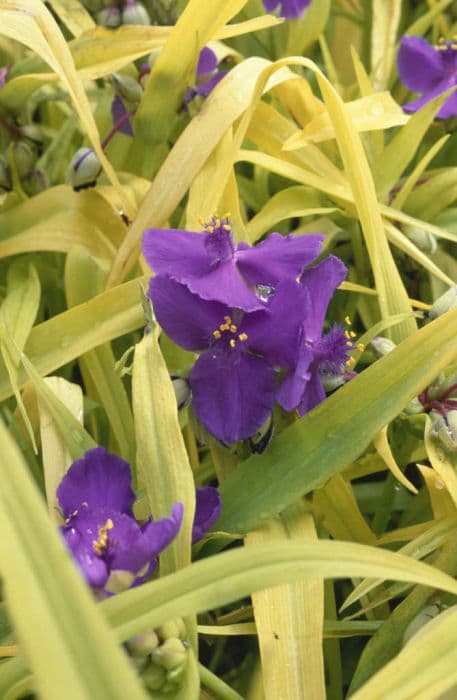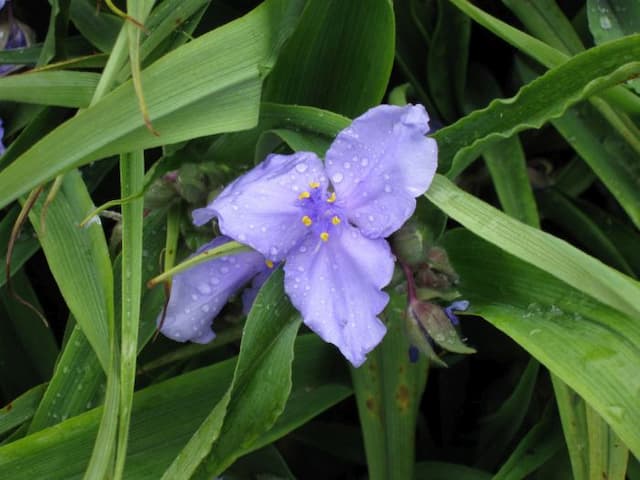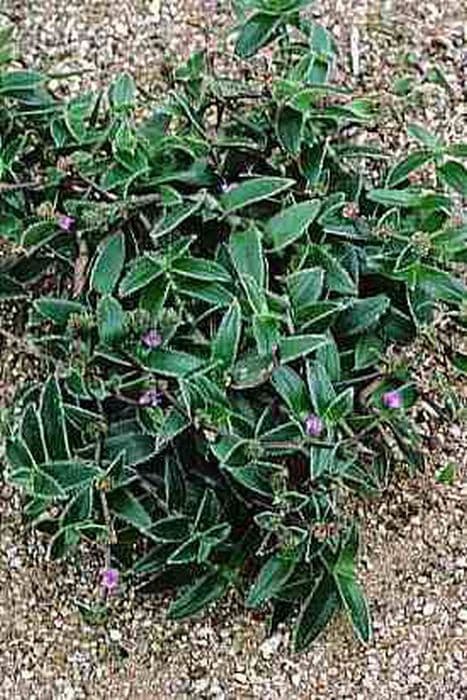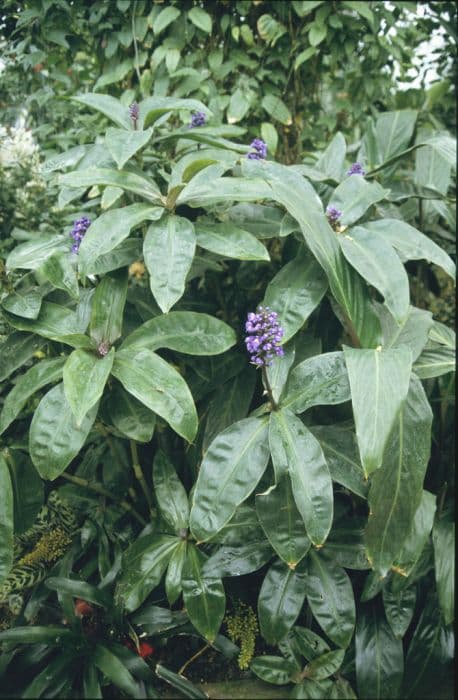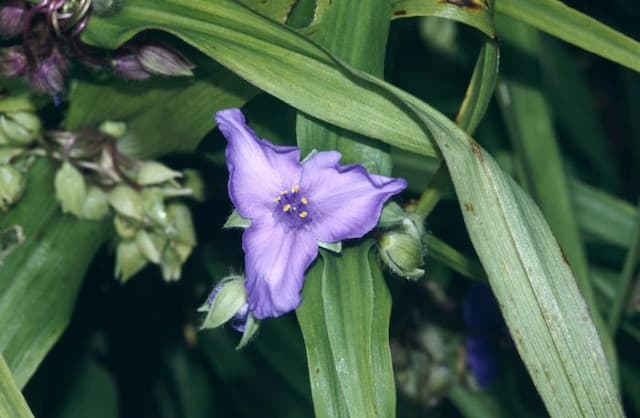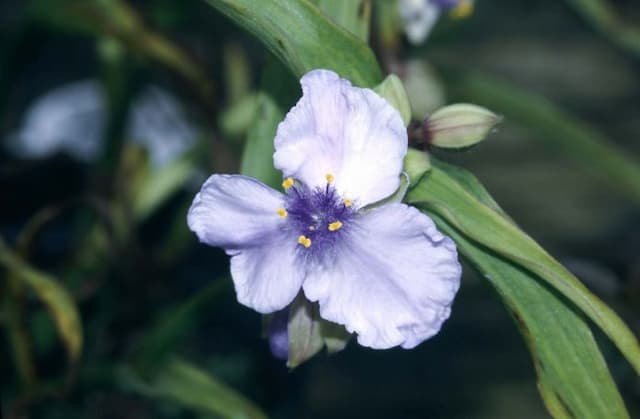Purple Heart Tradescantia pallida 'Purpurea'

ABOUT
Tradescantia pallida 'Purpurea', commonly known as purple heart, is a striking plant with a distinctive appearance. It boasts fleshy, elongated leaves with a deep, rich purple coloration. These leaves are glossy and sometimes bear small, faint, pale lines across their surface, enhancing their ornamental appeal. They are arranged alternately along the stems, creating a cascading or spreading form that adds to the plant's visual interest. The purple heart plant also features small, three-petaled flowers that are typically a pale purple or pink hue. These delicate flowers emerge intermittently throughout the growing season, nestled within the upper leaf axils, adding a gentle contrast to the darker foliage. The overall impression of the plant is one of vibrant color and graceful form, making it a popular choice for both indoor decor and outdoor landscaping as a ground cover or hanging feature. Despite its exotic looks, the purple heart is also valued for its hardiness and ease of care.
About this plant
 Names
NamesFamily
Commelinaceae
Synonyms
Purple Heart, Purple Queen, Wandering Jew, Purple Secretia
Common names
Setcreasea pallida, Setcreasea purpurea, Tradescantia purpurea.
 Toxicity
ToxicityTo humans
The plant commonly known as Purple Heart is not considered highly toxic to humans. However, ingestion can cause mild symptoms in some individuals, such as nausea, vomiting, or diarrhea. The sap may cause skin irritation or an allergic reaction upon contact. If a person ingests parts of the plant or experiences adverse reactions after handling it, seeking medical advice is recommended.
To pets
Purple Heart is considered non-toxic to pets, such as dogs and cats. However, ingestion of the plant may cause mild gastrointestinal upset, including symptoms such as vomiting or diarrhea. As with any non-food item consumed by a pet, it is wise to monitor the animal and consult with a veterinarian if any unusual signs are observed or if symptoms persist.
 Characteristics
CharacteristicsLife cycle
Perennials
Foliage type
Evergreen
Color of leaves
Purple
Flower color
Pink
Height
0.5-1 feet (15-30 cm)
Spread
1-2 feet (30-60 cm)
Plant type
Herb
Hardiness zones
8-11
Native area
Mexico
Benefits
 General Benefits
General Benefits- Easy to grow: Tradescantia pallida 'Purpurea', commonly known as Purple Heart, is adaptable to a range of growing conditions and can thrive indoors with minimal care.
- Drought tolerant: Once established, Purple Heart plants can withstand periods of low water availability, making them suitable for xeriscaping and water-efficient gardening.
- Rapid growth: These plants grow quickly and are excellent for filling in spaces in the garden or as ground cover, providing lush aesthetics with less wait time.
- Propagation: Purple Heart is easy to propagate from stem cuttings, which allows gardeners to expand their plantings or share with friends without additional cost.
- Pest resistant: This plant is relatively resistant to pests, reducing the need for chemical treatments and making it a more environmentally friendly option.
- Versatile: Purple Heart can be used in a variety of garden settings, including hanging baskets, container gardens, and as a trailing plant over walls.
- Soil improvement: Its extensive root system can help improve soil structure and quality over time.
- Attracts wildlife: The small, three-petaled flowers can attract pollinators like bees and butterflies to the garden, supporting local ecosystems.
- Year-round interest: Its distinctive purple foliage provides visual interest throughout the year, not relying on seasonal flowers for its aesthetic appeal.
- Decorative: The rich, purple color of the plant's leaves makes it a popular choice for adding a splash of color to garden designs and interior decorations.
 Medical Properties
Medical PropertiesThis plant is not used for medical purposes.
 Air-purifying Qualities
Air-purifying QualitiesThis plant is not specifically known for air purifying qualities.
 Other Uses
Other Uses- Tradescantia pallida 'Purpurea', commonly known as Purple Heart, can be used as a natural fabric dye, giving textiles a light purple or gray hue.
- In craft activities, stems and leaves of Purple Heart can be included in botanical scrapbooking and pressed flower projects for their vibrant color.
- Because of its striking color, Purple Heart is often used in floral arrangements as a contrasting foliage to complement a variety of flowers.
- It is used as a living mulch in garden beds, where its dense growth can help suppress weeds and retain soil moisture.
- Purple Heart plants are used as an indicator of overwatering, as their leaves will turn a more greenish color when watered too much.
- Some educators use Purple Heart to teach children about plant propagation, due to its easy and rapid rooting from stem cuttings.
- The plant is sometimes used as a border in fantasy-themed gardens due to its vivid magenta foliage that contributes to the fantastical aesthetic.
- In terrariums, small cuttings of Purple Heart can be used to add a pop of color against the traditionally green palette of these miniature ecosystems.
- Gardeners may utilize Purple Heart's ability to trail and climb in creating living walls or for draping over retaining walls for an aesthetic effect.
- During the Halloween season, crafters might use the Purple Heart plant to create a spooky and dark plant arrangement because of its deep purple, almost black foliage.
Interesting Facts
 Feng Shui
Feng ShuiThe Purple Heart is not used in Feng Shui practice.
 Zodiac Sign Compitability
Zodiac Sign CompitabilityThe Purple Heart is not used in astrology practice.
 Plant Symbolism
Plant Symbolism- Resilience: Tradescantia pallida, commonly known as Purple Heart, has the ability to thrive in various conditions, symbolizing resilience and perseverance in tough situations.
- Transformation: The plant's ability to change color from green to purple under the right light conditions represents transformation and adaptability.
- Healing: Purple Heart has been used in traditional medicine, and its association with the color purple, which is often linked to healing, gives it a symbolic meaning of health and recovery.
 Water
WaterPurple Heart should be watered when the top inch of soil feels dry to the touch, which typically means once a week, but this frequency can vary depending on light and temperature conditions. Use room temperature water and gently pour it around the base of the plant until water runs out of the drainage holes, which might be approximately one-half gallon for a medium-sized pot. During its active growing season in spring and summer, you may need to water more frequently, while in fall and winter, reduce watering to every other week or less, depending on the soil moisture.
 Light
LightPurple Heart thrives best in bright, indirect sunlight but can tolerate some direct sunlight, especially in the morning. A spot near an east or north-facing window is ideal, as it provides the plant with the right amount of natural light without the harsh afternoon sun. Too much direct sunlight can lead to leaf burn, while too little light can cause the foliage to lose its vibrant purple color.
 Temperature
TemperaturePurple Heart prefers temperatures between 60 to 80 degrees Fahrenheit and can handle occasional fluctuations outside this range. Avoid exposure to temperatures below 50 degrees Fahrenheit, as cold drafts and frost can seriously damage the plant. It's best to keep it in an environment with a stable temperature to encourage healthy growth.
 Pruning
PruningPruning Purple Heart is essential to maintain its bushy shape and encourage fuller growth. Snip off long, leggy stems and any yellow or dead leaves using clean scissors or pruning shears. It is best to prune in spring or early summer, which coincides with its active growing period, and can be done every few months to keep the plant tidy and healthy.
 Cleaning
CleaningAs needed
 Soil
SoilPurple Heart enjoys a well-draining potting mix with a pH ranging from 6 to 7. A combination of peat, compost, perlite, and pine bark is ideal for ensuring good drainage and aeration, which are crucial for the roots to develop properly and avoid waterlogging.
 Repotting
RepottingPurple Heart should generally be repotted every 1-2 years, or when it becomes root-bound. Spring or early summer is the best time to repot this plant to allow for active growth post-transplant.
 Humidity & Misting
Humidity & MistingPurple Heart thrives in moderate to high humidity, ideally between 40% and 60%. Too low humidity might cause the leaves to lose their vibrant color and become dry.
 Suitable locations
Suitable locationsIndoor
Provide bright, indirect light, and keep the soil moist.
Outdoor
Position in partial shade, water regularly, protect from frost.
Hardiness zone
9-11 USDA
 Life cycle
Life cycleThe life of Tradescantia pallida 'Purpurea', commonly known as purple heart, starts with seed germination in a warm and moist environment. Emerging seedlings will develop a small rosette of purple-tinted leaves as they mature into juvenile plants. The purple heart then enters a vegetative stage, during which it produces long, trailing stems and vibrant purple leaves, capable of rooting at the nodes when in contact with soil. It blooms in the warmer months, producing small, three-petaled pink to purple flowers. After pollination, these flowers can produce seed pods containing tiny seeds that, once mature, can disperse to start new plants. Over time, as older stems become wooden and the plant becomes denser, it may require pruning to encourage fresh growth and maintain a fuller, more attractive shape.
 Propogation
PropogationPropogation time
Spring-Summer
The most popular method to propagate Tradescantia pallida 'Purpurea', commonly known as Purple Heart or Purple Queen, is by stem cuttings. This is best done in Spring or early Summer when the plant is actively growing. To propagate by stem cuttings, select a healthy stem that is about 4 to 6 inches (10 to 15 centimeters) long and cut just below a node, the point where leaves attach to the stem. Remove the leaves from the lower half of the cutting to expose nodes. These nodes, once in contact with soil or water, will initiate root growth. You can then place the cutting either directly into moist soil or let it root in water by placing it in a glass with enough water to submerge the nodes but not the leaves. If rooted in water, transplant the cutting into soil once the roots are about an inch long (2.5 centimeters), which usually takes a few weeks.

